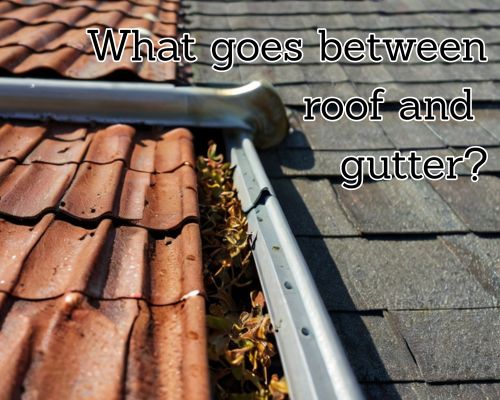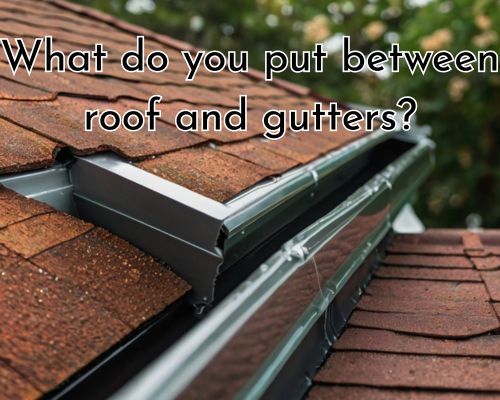
What Goes Between Roof and Gutter? Understanding the Critical Barrier for Your Home in Melbourne, Australia What Goes Between Roof and Gutter? Understanding the Critical Barrier for Your Home in Melbourne, Australia
When it comes to maintaining the integrity of your home, understanding the components that protect it from the elements is essential. One often-overlooked aspect of your roof system is the space between the roof and the gutter. This area plays a crucial role in ensuring your home remains safe, dry, and structurally sound. Steve Arnie of Gutter Cleaning Melbourne has to say that if you’re a homeowner in Melbourne, Australia, or the surrounding areas, it’s essential to understand what goes between your roof and gutter, how it functions, and why it should never be ignored.

What is Between the Roof and the Gutter?
Between the roof and the gutter, you’ll typically find a few critical components that work together to ensure the smooth flow of water and prevent leaks. The most common elements found in this space include:
- Fascia Board
- Gutter Guard
- Flashing
- Drip Edge
These components are vital for keeping your roofing system functioning correctly, especially in regions like Melbourne, which is prone to unpredictable weather conditions. Let’s break down each of these elements to see how they work.
1. Fascia Board: The Backbone of Your Gutter System
The fascia board is the long, horizontal board that runs along the edge of your roof, directly beneath the roof’s edge. It is typically made from timber, PVC, or metal, and it serves several critical purposes.
In addition to providing support for the guttering system, the fascia also helps protect the roof structure from moisture and debris buildup. The fascia acts as a barrier, preventing water from seeping into the rafters or the roof structure beneath. It also provides an attachment point for the gutter system, making it a vital part of the roofing structure.
2. Gutter Guard: Preventing Clogs and Protecting Your Roof
In Melbourne, especially during autumn when leaves are in abundance, gutters are prone to becoming clogged with debris like leaves, twigs, and dirt. This is where gutter guards come in. Gutter guards are protective mesh or filters installed over your gutters to prevent debris from entering the gutter system and causing blockages.
Gutter guards are an essential addition to any home’s guttering system, as they help reduce the frequency of cleaning and maintenance. With the unpredictable weather in Melbourne, including heavy rainfall, a clogged gutter can lead to water overflow and even damage your home’s foundation. Gutter guards ensure that rainwater flows freely, preventing costly repairs down the line.
3. Flashing: Preventing Water Infiltration
Flashing is a metal barrier that is installed along vulnerable areas where the roof meets the gutter or around any roof penetrations, such as chimneys or vents. Flashing’s primary purpose is to prevent water from seeping into the roofing structure.
Without proper flashing, water can infiltrate the joints between the roof and gutter, leading to leaks and potential water damage inside your home. In Melbourne, where heavy rainfall can occur at any time of the year, flashing is an essential component to ensure the durability and longevity of your roof and gutter system.
4. Drip Edge: Directing Water Into the Gutter
The drip edge is a metal or plastic strip that is installed at the edge of your roof, hanging slightly over the gutter. The purpose of the drip edge is to direct water into the gutter rather than letting it drip down the side of your home. This helps prevent water damage to your fascia and the external walls of your property.
Melbourne’s coastal climate, with its significant rainfall and occasional storms, makes the use of a drip edge crucial. Without it, water could accumulate along the edges of your roof, leading to the deterioration of the fascia and potentially creating an entry point for water into your home.
For professional needs, just go to https://gutter-cleaning-melbourne.com.au/.
Why Does It Matter?
Understanding what goes between the roof and gutter is essential for Melbourne homeowners because the weather in this city can be unpredictable. With annual rainfall that averages over 500mm, and the potential for sudden storms, your gutter system needs to work efficiently. The components between your roof and gutter help direct water away from your home’s exterior and prevent damage to your property.
Common Problems in Melbourne Homes
While the roof-gutter connection is often overlooked, ignoring it can lead to various problems, especially in Melbourne’s unique climate. Here are some common issues homeowners face:
- Clogged Gutters: If debris accumulates in your gutters, it can lead to blockages. When water cannot flow freely through the gutter, it can overflow, causing water to damage the roof, fascia, or even seep into the home.
- Water Damage to Fascia: Without proper flashing or a drip edge, water can cause the fascia board to rot, compromising the structural integrity of the roof. This can lead to costly repairs.
- Rust and Corrosion: The metal components between your roof and gutter, such as flashing and drip edges, are vulnerable to rust and corrosion, especially in Melbourne’s humid coastal environment.
- Leaks and Mold: Without proper flashing, water can infiltrate the roofing system, leading to leaks and potential mold growth in your attic or walls.
Maintenance Tips for Homeowners in Melbourne
Maintaining the roof and gutter system of your home is essential to ensure it performs optimally. Here are some simple maintenance tips for homeowners in Melbourne:
- Regular Gutter Cleaning: Clean your gutters at least twice a year to remove debris and prevent blockages. During autumn, make sure to clean them more frequently as fallen leaves can quickly clog your system.
- Inspect Fascia and Flashing: Regularly check your fascia boards and flashing for signs of damage or wear. Look for any rust, rot, or gaps that could allow water to infiltrate.
- Install Gutter Guards: If you haven’t already, consider installing gutter guards to protect your gutters from debris and reduce maintenance needs.
- Check for Leaks: Inspect your roof and gutters after heavy rain to ensure there are no leaks or signs of water damage.
Why Proper Installation is Key in Melbourne
Proper installation of the components between your roof and gutter is critical for ensuring the longevity and effectiveness of your guttering system. If not installed correctly, these elements may fail to perform their intended functions, leading to costly repairs and potential water damage.
If you’re unsure about the condition of your roof and gutter system, it’s wise to consult with a local professional in Melbourne who can inspect your home and offer advice on repairs or upgrades.
Conclusion
The space between your roof and gutter may seem insignificant, but it plays a crucial role in protecting your home from water damage. In Melbourne, where weather conditions can be unpredictable, ensuring that your fascia, gutter guard, flashing, and drip edge are in top condition is essential. By understanding these components and maintaining your gutter system, you can safeguard your home from costly repairs and potential structural damage. Regular inspections and maintenance will go a long way in preserving the integrity of your roof and gutters for years to come.
